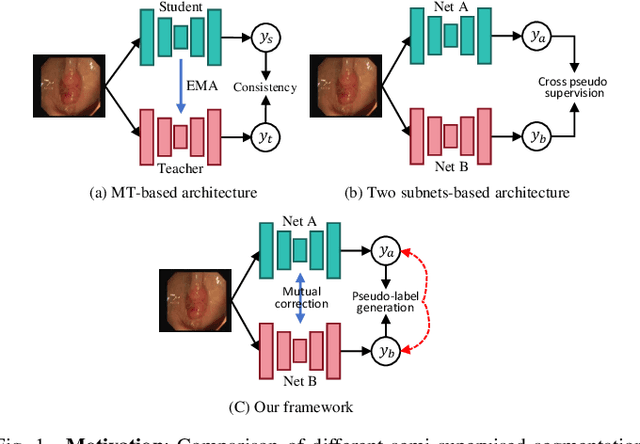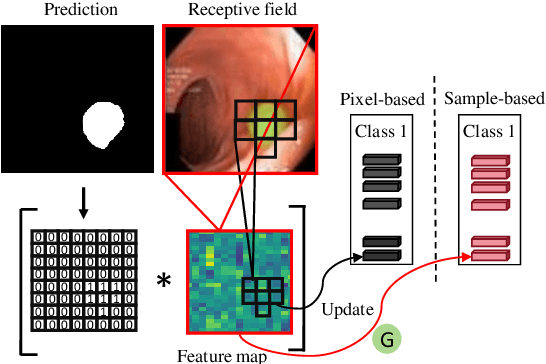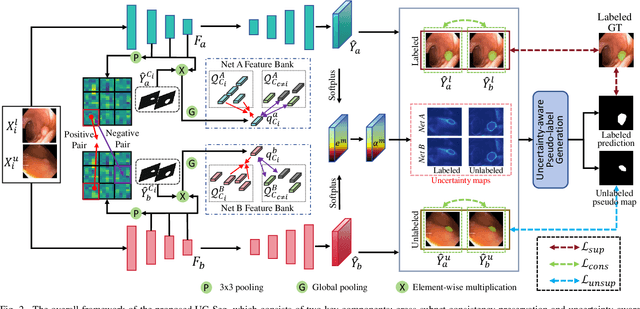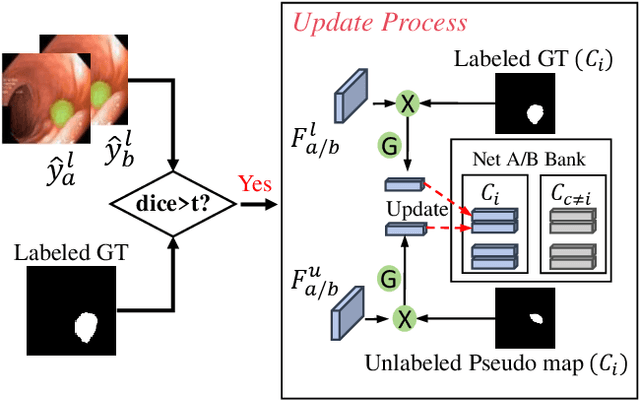Tao Zhou
Hierarchical Spatio-temporal Segmentation Network for Ejection Fraction Estimation in Echocardiography Videos
Aug 26, 2025Abstract:Automated segmentation of the left ventricular endocardium in echocardiography videos is a key research area in cardiology. It aims to provide accurate assessment of cardiac structure and function through Ejection Fraction (EF) estimation. Although existing studies have achieved good segmentation performance, their results do not perform well in EF estimation. In this paper, we propose a Hierarchical Spatio-temporal Segmentation Network (\ourmodel) for echocardiography video, aiming to improve EF estimation accuracy by synergizing local detail modeling with global dynamic perception. The network employs a hierarchical design, with low-level stages using convolutional networks to process single-frame images and preserve details, while high-level stages utilize the Mamba architecture to capture spatio-temporal relationships. The hierarchical design balances single-frame and multi-frame processing, avoiding issues such as local error accumulation when relying solely on single frames or neglecting details when using only multi-frame data. To overcome local spatio-temporal limitations, we propose the Spatio-temporal Cross Scan (STCS) module, which integrates long-range context through skip scanning across frames and positions. This approach helps mitigate EF calculation biases caused by ultrasound image noise and other factors.
Frequency-adaptive tensor neural networks for high-dimensional multi-scale problems
Aug 21, 2025Abstract:Tensor neural networks (TNNs) have demonstrated their superiority in solving high-dimensional problems. However, similar to conventional neural networks, TNNs are also influenced by the Frequency Principle, which limits their ability to accurately capture high-frequency features of the solution. In this work, we analyze the training dynamics of TNNs by Fourier analysis and enhance their expressivity for high-dimensional multi-scale problems by incorporating random Fourier features. Leveraging the inherent tensor structure of TNNs, we further propose a novel approach to extract frequency features of high-dimensional functions by performing the Discrete Fourier Transform to one-dimensional component functions. This strategy effectively mitigates the curse of dimensionality. Building on this idea, we propose a frequency-adaptive TNNs algorithm, which significantly improves the ability of TNNs in solving complex multi-scale problems. Extensive numerical experiments are performed to validate the effectiveness and robustness of the proposed frequency-adaptive TNNs algorithm.
Uncertainty-aware Cross-training for Semi-supervised Medical Image Segmentation
Aug 12, 2025



Abstract:Semi-supervised learning has gained considerable popularity in medical image segmentation tasks due to its capability to reduce reliance on expert-examined annotations. Several mean-teacher (MT) based semi-supervised methods utilize consistency regularization to effectively leverage valuable information from unlabeled data. However, these methods often heavily rely on the student model and overlook the potential impact of cognitive biases within the model. Furthermore, some methods employ co-training using pseudo-labels derived from different inputs, yet generating high-confidence pseudo-labels from perturbed inputs during training remains a significant challenge. In this paper, we propose an Uncertainty-aware Cross-training framework for semi-supervised medical image Segmentation (UC-Seg). Our UC-Seg framework incorporates two distinct subnets to effectively explore and leverage the correlation between them, thereby mitigating cognitive biases within the model. Specifically, we present a Cross-subnet Consistency Preservation (CCP) strategy to enhance feature representation capability and ensure feature consistency across the two subnets. This strategy enables each subnet to correct its own biases and learn shared semantics from both labeled and unlabeled data. Additionally, we propose an Uncertainty-aware Pseudo-label Generation (UPG) component that leverages segmentation results and corresponding uncertainty maps from both subnets to generate high-confidence pseudo-labels. We extensively evaluate the proposed UC-Seg on various medical image segmentation tasks involving different modality images, such as MRI, CT, ultrasound, colonoscopy, and so on. The results demonstrate that our method achieves superior segmentation accuracy and generalization performance compared to other state-of-the-art semi-supervised methods. Our code will be released at https://github.com/taozh2017/UCSeg.
LVM-GP: Uncertainty-Aware PDE Solver via coupling latent variable model and Gaussian process
Jul 30, 2025Abstract:We propose a novel probabilistic framework, termed LVM-GP, for uncertainty quantification in solving forward and inverse partial differential equations (PDEs) with noisy data. The core idea is to construct a stochastic mapping from the input to a high-dimensional latent representation, enabling uncertainty-aware prediction of the solution. Specifically, the architecture consists of a confidence-aware encoder and a probabilistic decoder. The encoder implements a high-dimensional latent variable model based on a Gaussian process (LVM-GP), where the latent representation is constructed by interpolating between a learnable deterministic feature and a Gaussian process prior, with the interpolation strength adaptively controlled by a confidence function learned from data. The decoder defines a conditional Gaussian distribution over the solution field, where the mean is predicted by a neural operator applied to the latent representation, allowing the model to learn flexible function-to-function mapping. Moreover, physical laws are enforced as soft constraints in the loss function to ensure consistency with the underlying PDE structure. Compared to existing approaches such as Bayesian physics-informed neural networks (B-PINNs) and deep ensembles, the proposed framework can efficiently capture functional dependencies via merging a latent Gaussian process and neural operator, resulting in competitive predictive accuracy and robust uncertainty quantification. Numerical experiments demonstrate the effectiveness and reliability of the method.
Text-driven Multiplanar Visual Interaction for Semi-supervised Medical Image Segmentation
Jul 16, 2025Abstract:Semi-supervised medical image segmentation is a crucial technique for alleviating the high cost of data annotation. When labeled data is limited, textual information can provide additional context to enhance visual semantic understanding. However, research exploring the use of textual data to enhance visual semantic embeddings in 3D medical imaging tasks remains scarce. In this paper, we propose a novel text-driven multiplanar visual interaction framework for semi-supervised medical image segmentation (termed Text-SemiSeg), which consists of three main modules: Text-enhanced Multiplanar Representation (TMR), Category-aware Semantic Alignment (CSA), and Dynamic Cognitive Augmentation (DCA). Specifically, TMR facilitates text-visual interaction through planar mapping, thereby enhancing the category awareness of visual features. CSA performs cross-modal semantic alignment between the text features with introduced learnable variables and the intermediate layer of visual features. DCA reduces the distribution discrepancy between labeled and unlabeled data through their interaction, thus improving the model's robustness. Finally, experiments on three public datasets demonstrate that our model effectively enhances visual features with textual information and outperforms other methods. Our code is available at https://github.com/taozh2017/Text-SemiSeg.
Continual Retinal Vision-Language Pre-training upon Incremental Imaging Modalities
Jun 24, 2025Abstract:Traditional fundus image analysis models focus on single-modal tasks, ignoring fundus modality complementarity, which limits their versatility. Recently, retinal foundation models have emerged, but most still remain modality-specific. Integrating multiple fundus imaging modalities into a single foundation model is valuable. However, in dynamic environments, data from different modalities often arrive incrementally, necessitating continual pre-training. To address this, we propose RetCoP, the first continual vision-language pre-training framework in the fundus domain, which incrementally integrates image and text features from different imaging modalities into a single unified foundation model. To mitigate catastrophic forgetting in continual pre-training, we introduce a rehearsal strategy utilizing representative image-text pairs and an off-diagonal information distillation approach. The former allows the model to revisit knowledge from previous stages, while the latter explicitly preserves the alignment between image and text representations. Experiments show that RetCoP outperforms all the compared methods, achieving the best generalization and lowest forgetting rate. The code can be found at https://github.com/Yuang-Yao/RetCoP.
Universal Incremental Learning: Mitigating Confusion from Inter- and Intra-task Distribution Randomness
Mar 10, 2025Abstract:Incremental learning (IL) aims to overcome catastrophic forgetting of previous tasks while learning new ones. Existing IL methods make strong assumptions that the incoming task type will either only increases new classes or domains (i.e. Class IL, Domain IL), or increase by a static scale in a class- and domain-agnostic manner (i.e. Versatile IL (VIL)), which greatly limit their applicability in the unpredictable and dynamic wild. In this work, we investigate $\textbf{Universal Incremental Learning (UIL)}$, where a model neither knows which new classes or domains will increase along sequential tasks, nor the scale of the increments within each task. This uncertainty prevents the model from confidently learning knowledge from all task distributions and symmetrically focusing on the diverse knowledge within each task distribution. Consequently, UIL presents a more general and realistic IL scenario, making the model face confusion arising from inter-task and intra-task distribution randomness. To $\textbf{Mi}$tigate both $\textbf{Co}$nfusion, we propose a simple yet effective framework for UIL, named $\textbf{MiCo}$. At the inter-task distribution level, we employ a multi-objective learning scheme to enforce accurate and deterministic predictions, and its effectiveness is further enhanced by a direction recalibration module that reduces conflicting gradients. Moreover, at the intra-task distribution level, we introduce a magnitude recalibration module to alleviate asymmetrical optimization towards imbalanced class distribution. Extensive experiments on three benchmarks demonstrate the effectiveness of our method, outperforming existing state-of-the-art methods in both the UIL scenario and the VIL scenario. Our code will be available at $\href{https://github.com/rolsheng/UIL}{here}$.
MM-Retinal V2: Transfer an Elite Knowledge Spark into Fundus Vision-Language Pretraining
Jan 27, 2025



Abstract:Vision-language pretraining (VLP) has been investigated to generalize across diverse downstream tasks for fundus image analysis. Although recent methods showcase promising achievements, they significantly rely on large-scale private image-text data but pay less attention to the pretraining manner, which limits their further advancements. In this work, we introduce MM-Retinal V2, a high-quality image-text paired dataset comprising CFP, FFA, and OCT image modalities. Then, we propose a novel fundus vision-language pretraining model, namely KeepFIT V2, which is pretrained by integrating knowledge from the elite data spark into categorical public datasets. Specifically, a preliminary textual pretraining is adopted to equip the text encoder with primarily ophthalmic textual knowledge. Moreover, a hybrid image-text knowledge injection module is designed for knowledge transfer, which is essentially based on a combination of global semantic concepts from contrastive learning and local appearance details from generative learning. Extensive experiments across zero-shot, few-shot, and linear probing settings highlight the generalization and transferability of KeepFIT V2, delivering performance competitive to state-of-the-art fundus VLP models trained on large-scale private image-text datasets. Our dataset and model are publicly available via https://github.com/lxirich/MM-Retinal.
Self-adaptive vision-language model for 3D segmentation of pulmonary artery and vein
Jan 07, 2025Abstract:Accurate segmentation of pulmonary structures iscrucial in clinical diagnosis, disease study, and treatment planning. Significant progress has been made in deep learning-based segmentation techniques, but most require much labeled data for training. Consequently, developing precise segmentation methods that demand fewer labeled datasets is paramount in medical image analysis. The emergence of pre-trained vision-language foundation models, such as CLIP, recently opened the door for universal computer vision tasks. Exploiting the generalization ability of these pre-trained foundation models on downstream tasks, such as segmentation, leads to unexpected performance with a relatively small amount of labeled data. However, exploring these models for pulmonary artery-vein segmentation is still limited. This paper proposes a novel framework called Language-guided self-adaptive Cross-Attention Fusion Framework. Our method adopts pre-trained CLIP as a strong feature extractor for generating the segmentation of 3D CT scans, while adaptively aggregating the cross-modality of text and image representations. We propose a s pecially designed adapter module to fine-tune pre-trained CLIP with a self-adaptive learning strategy to effectively fuse the two modalities of embeddings. We extensively validate our method on a local dataset, which is the largest pulmonary artery-vein CT dataset to date and consists of 718 labeled data in total. The experiments show that our method outperformed other state-of-the-art methods by a large margin. Our data and code will be made publicly available upon acceptance.
Self-Calibrated Dual Contrasting for Annotation-Efficient Bacteria Raman Spectroscopy Clustering and Classification
Dec 28, 2024Abstract:Raman scattering is based on molecular vibration spectroscopy and provides a powerful technology for pathogenic bacteria diagnosis using the unique molecular fingerprint information of a substance. The integration of deep learning technology has significantly improved the efficiency and accuracy of intelligent Raman spectroscopy (RS) recognition. However, the current RS recognition methods based on deep neural networks still require the annotation of a large amount of spectral data, which is labor-intensive. This paper presents a novel annotation-efficient Self-Calibrated Dual Contrasting (SCDC) method for RS recognition that operates effectively with few or no annotation. Our core motivation is to represent the spectrum from two different perspectives in two distinct subspaces: embedding and category. The embedding perspective captures instance-level information, while the category perspective reflects category-level information. Accordingly, we have implemented a dual contrastive learning approach from two perspectives to obtain discriminative representations, which are applicable for Raman spectroscopy recognition under both unsupervised and semi-supervised learning conditions. Furthermore, a self-calibration mechanism is proposed to enhance robustness. Validation of the identification task on three large-scale bacterial Raman spectroscopy datasets demonstrates that our SCDC method achieves robust recognition performance with very few (5$\%$ or 10$\%$) or no annotations, highlighting the potential of the proposed method for biospectral identification in annotation-efficient clinical scenarios.
 Add to Chrome
Add to Chrome Add to Firefox
Add to Firefox Add to Edge
Add to Edge